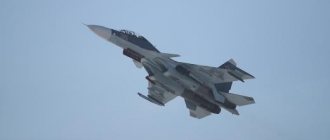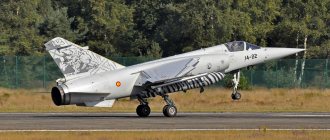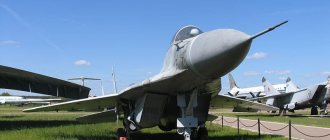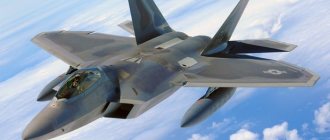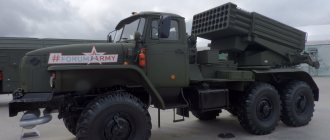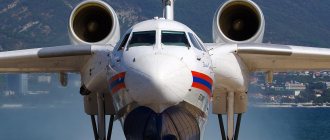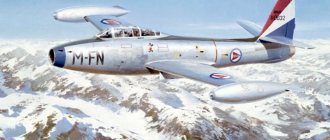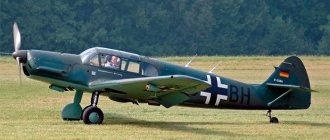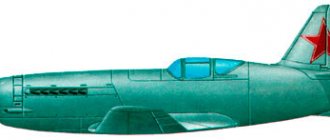The Panavia Tornado jet military aircraft was developed by the German company together with the British Aerospace and the Italian Alenia Aeronautica in the early 1970s.
This aircraft exists in 2 variations: fighter-bomber (GR4) and reconnaissance-interceptor (GR4A).
Structural features include a variable sweep wing depending on the mission and flight conditions.
In total, Great Britain built 249 fighter-bombers and 195 interceptors. As of 2011, the RAF has 125 modernized Tornado aircraft (GR4 and GR4A).
The Tornado jet aircraft is a 2-seater aircraft capable of performing a wide range of combat missions at any time of the day and in any weather conditions. The aircraft is equipped with 2 RB199 Mk103 turbojet engines. The Tornado is capable of flying at both supersonic and high subsonic speeds. It is capable of flying at low altitudes in automatic flight mode thanks to the presence of a ground scanner. This is especially useful in poor weather conditions when visual visibility is limited. The aircraft is also equipped with infrared and night vision devices.
The aircraft is equipped with a whole range of electronic reconnaissance and target acquisition equipment, such as the advanced RAPTOR (Reconnaissance Airborne Pod TORnado) system. For navigation there is a GPINS (Global Positioning Inertial Navigation System) system. The aircraft is also equipped with a ground surface radar (GMR or Ground Mapping Radar). In addition to this, the aircraft has a Laser Targeting and Marked Target Search (LRMTS) system.
The appearance of the aircraft is quite recognizable. It has a short, thick fuselage with a very large, backward-sloping tail (2). Also, it has a curved wing type with a variable angle from 25 to 67 degrees (3). The aircraft is equipped with a 2-seater cabin and a short cone-shaped “nose” that points at the end. Two small capsules under the front of the fuselage are infrared, night vision and laser guidance systems. The easiest way to distinguish the GR4 Tornado from its predecessor, the F3 (in service with the RAF until 2011), is to compare the nose shape of both aircraft. The GR4 has a blunter and thicker nose, while the F3 has a more elongated and much thinner nose. Also, F3 is about 2m longer.
Technical characteristics of the Tornado fighter:
Crew: 2 people Load capacity: up to 9000 kg Length: 16.8 m Wingspan: 8.6 m - 13.9 m (depending on the current sweep angle) Height: 6 m Empty weight: 14100 kg Normal curb weight: 20400 kg Maximum lift weight: 27200 kg Engines : 2 Rolls-Royce RB199 turbojet engines, with thrust from 4380 kg/s to 7620 kg/s (with afterburner) Maximum speed: Mach 1.2 (at low altitude) - Mach 2.2 (2340 km/h) Cruising speed : Mach 0.9 (1112 km/h at low altitude) Fuel reserve in combat mode: 1390 km Fuel reserve during ferrying: 3890 km Service ceiling: 15000 m Required runway length: 760 m
Typhoon is not the same. Experienced Hawker Tornado fighters. Great Britain
Home » Real story » Little-known and unrealized projects of aircraft and other flying equipment » Typhoon is not the same. Experienced Hawker Tornado fighters. Great Britain
Little-known and unrealized projects of aircraft and other flying equipment
byakin 05/14/2021 971
16
in Favoritesin Favoritesfrom Favorites 8
Experienced Hawker Tornado fighters. Great Britain
The Hawker company and its famous chief designer Sidney Camm in the second half of the 1930s and during the Second World War worked on a series of fighters whose names were borrowed from destructive natural phenomena: Hurricane, Tornado, Typhoon. and Tempest. Ironically, the machine named after the most destructive of all, the tornado, actually turned out to be the least destructive.
In 1937, it became known to the well-informed public that British engine companies were working on the development of “heavy-duty” engines producing more than 2,000 hp. (1470 kW). These were 24-cylinder in-line liquid-cooled Napier Saber H-type engines and Rolls-Royce Vulture X-type engines. Sidney Camm first developed a design for a fighter powered by a Saber engine and armed with twelve wing-mounted 7.7 mm machine guns, and sent the documentation to the Air Ministry in July 1937. The documentation was reviewed and specification F.18/37 was issued in January 1938, from which prototype development began.
Later Sidney Camm designed one aircraft for both types of engines. The new car had an all-metal wing with a rather thick aerodynamic profile and, in front view, resembled a strongly flattened letter W (reverse gull wing). The forward part of the fuselage, ending behind the cockpit, had a power set in the form of a truss welded from steel pipes and a skin made from panels made from metal sheets. From the cockpit to the rear end, the fuselage was of monocoque all-metal construction. The pilot's cabin was closed; entry and exit were through a door located on the left side of the fuselage. The vehicle was distinguished by an unusually wide track of the main landing gear wheels. With the Saber engine, the letter N (Napier) was added to the designation of the basic project, with the Vulture engine - the letter R (Rolls-Royce).
In August, the Ministry of Aviation ordered four prototypes of these aircraft, two of each version. The first prototype of the R version (military number P5219) made its maiden flight on October 6, 1939, and by the time of the first flight the name Tornado had been chosen for the vehicle. The first stage of flight testing went very smoothly and successfully. In the fall of 1939, Hawker received an order for 500 production Tornado I aircraft.
diagram of the first prototype of the Hawker Tornado R fighter (military number P5219)
The problem arose when pilots reached higher speeds. It turned out that the radiator, located under the fuselage much like a Hurricane fighter (but slightly shifted forward), created an unfavorable aerodynamic effect. The prototype was modernized and from 6 December 1939 it flew with a new radiator suspended under the forward fuselage just behind the propeller. In both cases, a 1,760-horsepower (1,294 kW) Rolls-Royce Vulture II engine was used as a power plant, twelve 7.7 mm machine guns were placed in the wing, and the take-off weight was 4,200 kg. Flight performance was promising, but the prototype soon crashed.
first prototype Hawker Tornado R fighter (military number P5219) on the ground
first prototype Hawker Tornado R fighter (military number P5219) on the ground
The second prototype (military number P5224) did not first fly until December 6, 1940, because Hawker was busy mass-producing Hurricanes. It was only from October 1940 that Hawker was able to devote sufficient personnel and resources to the Tornado fighter program. Hawker received a new order for mass production, which was transferred to the AV Roe & Co. plant located in Manchester, Lancashire. Ltd. (Avro). The second prototype Tornado fighter was also equipped with a Vulture II engine, but instead of twelve machine guns, four 20 mm Hispano cannons were placed in the wing. Already during the tests, problems arose with the Vulture engine and its main “disease” - broken piston rod bolts - could not be eliminated. In early 1941, Hawker attempted to replace the Vulture engine with a different type of engine of similar power. Particular attention was paid to radial engines. However, in March 1941, the second prototype was equipped with a Vulture V engine producing 1,980 hp. (1455 kW). The only production vehicle, the Tornado I (R7936), was built in Manchester and first flew at Woodford on 29 August 1941. Production was then stopped due to problems with the engines.
diagram of the second prototype of the Hawker Tornado R fighter (military number P5224)
second prototype Hawker Tornado fighter (military number P5224) on the ground
second prototype Hawker Tornado fighter (military number P5224) on the ground
second Hawker Tornado fighter prototype (military number P5224) in flight
In the heavy bomber category, a similar fate befell the Avro Manchester, whose development was also based on Vulture engines. The only production fighter, the Tornado I, remained at the flight test center and was used to test counter-rotating coaxial propellers.
The upper and side surfaces of the second Hawker Tornado fighter prototype (military number P5224) were painted dark green and brown. The lower surfaces were painted yellow. The propeller hub fairing was painted black. Identification marks were painted on the upper and lower surfaces of the wing and on the sides of the fuselage. The letter P inscribed in a thin circle is placed on the sides of the fuselage between the identification mark and the military number
In February 1941, Hawker received an order for a new version of the Tornado fighter, which was to be powered by an 18-cylinder Bristol Centaurus Ce.4S radial engine producing 2,210 hp. (1624 kW). The result of this work was the creation of the third prototype (military number HG641), the first flight of which took place on October 23, 1941. Aircraft manufacturers knew they had problems with the large radial engine's cowling, exhaust pipes, and oil cooler, but they could be overcome. Compared to the Vulture V-powered variant, the Centaurus-powered Tornado fighter was slightly faster (647 km/h versus 640 km/h), but inferior in climb rate and service ceiling. The Tornado (HG641) climbed to a height of 6100 meters in 8.4 minutes, while the Tornado (P5224) took 7.2 minutes, and the service ceiling was 10,000 meters versus 10,640 meters.
third prototype Hawker Tornado fighter (military number HG641) on the ground
third prototype Hawker Tornado fighter (military number HG641) on the ground
The upper and side surfaces of the third Hawker Tornado fighter prototype (military number HG641) were painted dark green and brown. The lower surfaces were painted yellow. The propeller hub fairing was painted black. Identification marks were painted on the upper and lower surfaces of the wing and on the sides of the fuselage. The letter P inscribed in a thin circle is placed on the sides of the fuselage between the identification mark and the military number
Much more successful, although not without problems, was the development of the N version of the aircraft with the Saber engine. This variant entered mass production under the designation Typhoon and was primarily used for ground assault missions. A further development of the Typhoon fighter-attack aircraft was the more advanced Tempest fighter. In developing the Centaurus radial-engined Tempest II variant, Hawker's design office drew on experience gained from the Tornado prototype (HG641).
FLIGHT PERFORMANCE
Type: Hawker Tornado
Purpose: fighter
Status: prototype
Manufacturing company:
Hawker Aircraft, Ltd., Kingston upon Thames, Surrey A. V. Roe & Co. Ltd., Manchester, Lancashire
Crew: 1 person
Powerplant: one 24-cylinder in-line liquid-cooled Vulture V engine, developing 1980 hp. (1455 kW) and rotating three-blade variable pitch propeller
Dimensions:
wingspan 12.78 m length 10.01 m height 4.47 m wing area 26.33 m²
Weight:
empty 3803 kg takeoff 4845 kg
Flight characteristics:
maximum speed at an altitude of 7020 meters 640 km/h time to climb 6100 meters 7.2 minutes service ceiling 10640 m flight range 965 km
Number of manufactured: 4 copies (3 prototypes + 1 production aircraft)
sources:
- text – VACLAV NĚMEČEK VÝKRES STANISLAV SMÉKAL “LETADLA 39-45 HAWKER TORNADO” “L+K” 20/83, p.791
- photos and diagram – https://www.airwar.ru/enc/fww2/tornado.html
Weapons and electronic systems:
Cannon armament: 2 x 27mm Mauser cannons Hardpoints: 7 Missile armament: up to 9 ALARM (Air Launched Anti-Radiation Missile) anti-radar missiles. These missiles detect radiation generated by enemy radar systems and destroy its sources. Also, aircraft can be equipped with short-range ASRAAM air-to-air missiles. Brimstone and Storm Shadow missiles. Bombs: Enhanced Paveway II and Paveway 3, 1000-pound Penguin bombs Laser target designation system: Litening Laser Designator Pod Complex reconnaissance and surveillance systems (including high-definition video systems ).
It is planned to systematically modernize some of the combat vehicles with the aim of maintaining them in the Air Force until 2025-2030.
Combat use of Tornado fighters
Tornado aircraft have successfully participated in many RAF operations since the 1990s. Behind them are the Gulf War (1991), in which 41 aircraft took part, a company in Iraq (1998 - 2011), Kosovo (1999), and the conflict in Libya in 2011. and the war in Afghanistan, which continues to this day (2012).
Combat jet Panavia Tornado (Germany)
On August 29 and September 20, Tornado GR.1 aircraft from the Royal Air Force were deployed to Mukhharak airbase in Bahrain (24 aircraft) and Tabuk in Saudi Arabia (18 aircraft). In January 1991, immediately before the outbreak of hostilities, six British TornadoGR reconnaissance aircraft were transferred to Dhahran. Mk 1A. In accordance with the plans of the joint command, TornadoGR.Mk1 fighter-bombers were assigned the role of “airfield destroyers.” Their first targets on the night of January 17 were the taxiways adjacent to the concrete caponiers. It was assumed that the destruction of the concrete covering would pin Iraqi planes in shelters to the ground for several hours. The Tornado's payload consisted of two JP233 bomb clusters, each loaded with 30 SG357 concrete-piercing submunitions and 215 HB876 anti-personnel mines. For self-defense, the aircraft were equipped with two A1M-9L Sidewinder missiles, and two 2250 liter tanks were suspended under the wing. Strike groups consisted of one or two units.
A group of four fighter-bombers, led by Commander D. Wits, attacked the Muharraq air base. Eight more aircraft, escorted by American F-15C fighters and Saudi TornadoF.Mk.3, hit the taxiways at Tallyli airfield. The submunitions were dropped at an extremely low altitude - 50-60 m. This is how one of its participants, navigator-operator D. Gregg, describes the first raid: “We rushed through the darkness, illuminated by flashes of fire escaping from under the fuselage of our vehicle (pyrocharges were working , pushing submunitions out of JP233 cassettes - author's note). The jolts and flashes of flame created the feeling that there was heavy fire on the plane and the explosions were falling very closely, right under our belly. I admit, I felt uneasy...”
Early in the morning of January 17, a TornadoGR.Mk1 flight (each plane carried four 450-kilogram bombs) struck the runway of the Shaybakh airfield, which ended in vain: not a single bomb hit the target. The relatively high bombing altitude (3000 m) made the work of Iraqi anti-aircraft gunners easier. A plane piloted by lieutenants A. Niccol and D. Peters was shot down by ZSU 57-2 fire. A cannon shell hit the warhead of a Sidewinder missile, causing a powerful explosion, but the crew managed to eject. In the evening of the same day, the attack on Shaybakh air base was repeated by four Tornados, this time equipped with JP233 cassettes. The submunitions had to be dropped at an extremely low altitude. However, the leader of the group, Commander N. Elsdon, “missed” and led his planes into a second attack. Iraqi anti-aircraft gunners again rose to the occasion and shot down the commander’s plane (the crew died). During the attack on the Mubaydah Bin Al Yarrah airbase, the plane piloted by N. Ingle was unlucky. Two herons collided with his car, and a few seconds later he was hit by a 23-mm artillery shell and several large-caliber bullets. However, the crew managed to carry out the bombing and safely brought their crippled aircraft to the home airfield. After repairs that took just over a day, the Tornado returned to service and took part in a combat mission again on January 19.
On January 18, British Air Force fighter-bombers destroyed three Tu-16 bombers at the airfield in Al Takkadum with 450-kilogram bombs. However, this success should be considered very doubtful, since the Tu-16 had long since exhausted its service life and was living out its days at the Iraqi airfield, not posing any threat to Allied aviation. Just as coolly, the Americans and British dealt with a large number of Hunters, MiG-21F13s and Il-28s that filled the sides of many Iraqi airfields.
On January 20, three Tornado flights attacked the Muharraq airbase. One aircraft was lost due to a technical malfunction (the crew managed to eject), and the rest, dividing into two groups in the target area, attacked the airfield from different directions: four aircraft from an altitude of 1800 bombed the runway with 450-kilogram bombs, and three aircraft " they seeded the taxiways with submunitions from JP233 cassettes. Iraqi air defense created a dense fire curtain, which significantly reduced the accuracy of the bombing (only one bomb hit the runway). While leaving the target, one plane was shot down by an S-20 air defense system at a range of 17 km, and the other by a pair of Iraqi MiG-29s (the crew ejected over an area controlled by the Kurds and escaped capture).
On January 20, the British Tornado began using 450- and 900-kilogram American-made Paveway II adjustable bombs with semi-active laser homing. Each plane carried two ammunition on board. Since the onboard equipment did not provide the possibility of laser illumination of the target, target designation was carried out from the ground by special sabotage groups equipped with laser searchlights or from American F-15E and F-111 aircraft. On January 23, one of the Tornados was shot down by the Osa air defense missile system after dropping the KAB. Some publications reported that “the vehicle hovered to illuminate the target, turning into an ideal target for missiles.” However, this fighter-bomber could not carry out any laser illumination (due to the lack of appropriate equipment), there was no need for it to “hover” over the target, so the Iraqi missilemen “worked” on the aircraft, freed from bombs and capable of performing anti-aircraft maneuvering.
Another Tornado fighter-bomber "missed" with a laser bomb, which instead of the bridge fell on the city bazaar, killing more than 100 civilians. On January 24, six BAE Bakanir 5.Mk.2B bombers, urgently transferred from Great Britain and equipped with American Westinghouse AN/ASQ-153 Pave Spike containers with laser and television equipment, began to be used for illumination. The targets for the KAB were mainly concrete shelters for aircraft, which were available in large quantities at Iraqi air bases.
Since February 6, two (all that were available) containers with an experimental navigation and targeting optical-electronic system TIALD, allowing the Tornado GR.Mk1 aircraft to autonomously highlight targets, arrived from the UK. Only six Tornado fighter-bombers were equipped to carry these containers.
On January 22, eight Tornado aircraft over the Al Ratbah area at an altitude of 6700 m were fired upon by KS-19 100-mm anti-aircraft guns. The leader's plane was shot down by the first salvo, and the rest of the fighter-bombers, hastily freed themselves from bombs, “dive” to a low altitude and headed for the home airfield.
After the Iraqi army began to withdraw from Kuwait, bridges over the Euphrates River became the most important targets for the RAF Tornado. These objects had powerful anti-aircraft cover, which included the Osa air defense system, so the attacks were carried out from a shallow dive from altitudes of 7300-4900 m. From February 7 to 10, 13 Iraqi bridges and crossings were destroyed, which made it very difficult for the enemy to organize an organized retreat. At night, aircraft with TIALD containers with a thermal imaging channel were used with great efficiency.
On February 13, six British Tornados (two of which carried TIALD containers), accompanied by three EF-111A electronic warfare aircraft and two US Air Force F-15C fighters, raided Al Taqqadum airbase. The next day the attack was repeated. While approaching the target, several S-75 missiles were fired at the fighter-bombers. The crews of the electronic warfare aircraft were confused and did not have time to “silence” the air defense missile guidance stations. The fighter-bombers, having detected the missile launches, urgently got rid of the bombs and rushed to saving low altitudes. According to the recollections of Lieutenant R. Clark, who was on board one of the British planes, “everyone was gripped by a terrible panic. The worst thing was that the missiles were rushing towards us from both sides and we did not know how many there were. I immediately freed myself from the pair of cabs and threw the plane onto the wing. At that moment the first rocket hit us. The explosion was somewhere behind, apparently under the tail. I can’t imagine what was going on there, but the blow was terrible. The cockpit glass shattered, but the engines still pulled. We planned for a minute or two, after which the pass was overtaken by a second missile, turning the plane into a pile of falling debris...” (Clark managed to eject and was captured by the Iraqis). This was the last British Tornado aircraft lost during the war.
In Operation Desert Storm, Tornado aircraft were the first to use light anti-radar missiles BAe ALARM, which showed relatively high efficiency in “breaking through” enemy air defenses. By the start of hostilities, testing of this missile had not yet been completed, and missiles from the experimental series were used against Iraq. Each fighter-bomber could carry up to eight missiles, but typically carried only two missiles to supplement other weapons. A total of about 123 missiles of this type were produced, 80% of which, according to British estimates, reached their target.
In addition to the British, Tornado fighter-bombers were used by the Italians during Operation Desert Storm, who deployed eight Tornado GR.l aircraft to the theater of operations. The first raid on the night of January 16-17 involved all eight Italian aircraft that took off from the airfield in Abu Dhabi. One fighter-bomber was forced to return to base due to technical problems with the landing gear. The remaining Tornados attempted to refuel in midair from American Boeing KC-135 tankers. However, powerful vortices generated by tanker aircraft, as well as the turbulent state of the atmosphere, made contact with the cone difficult (previously, Italian pilots had no experience interacting with the KC-135). After making a number of unsuccessful attempts, six Italian cars turned back. Only one fighter-bomber managed to refuel and it continued its flight to Baghdad, over which it was shot down by a pair of Iraqi MiG-23M interceptors. Subsequently, the Italians refueled only from Tornado aircraft, equipped with a container with the appropriate equipment. This almost halved the combat radius of fighter-bombers, and Italian Tornados until the end of the war were used only against targets at the front line or in the near rear.
In total, during the war, Tornado aircraft dropped 950 KAB "Paveway" and 4250 conventional free-fall bombs of 450 and 900 kg caliber, fired 123 ALARM missiles at enemy radar, and used 100 sets of JP233 bomb clusters. Losses amounted to 11 vehicles, with eight Tornado crew members killed and seven captured.
aYUGNBNI LNDKHTHYUZHHEI Tornado DNAFEM ASHK YARYURE SDYUPMSHI BYUPHYUMR, NDMYYN B OEPYAOEIRKHBE PYYAYALURPHBYUKYA X BYUPHYUMR RYURHVEYAINTSN PUGBEDVKHYU. mYUPЪDS I NYAMYUYEMHEL AYUGNBNI LNDKHTHYUZHHH ONDBEYAMSHLH PUGBEDSHBYUREKEMSHLH YNMREIMEPYULH ASHKH YANGDYUMSH KH DBE YAOEZHYUKHGHPNBYUMMSHE PUGBEDSHBYUREKEMSHE LNDKHTHYUZHH — GR.Mk 1st X eyyu.gYOOYUDMNTSEPLYUMYAYKHI eyyu YANGDUBUKYAJ MU GYULEMS RF-4E Phantom II X RF-104G Starfighter. ANKEE KHGBEYARMSHI ON ETSN YUMTSKKHIYAINLS NANGMYUVEEMHCH ECR
(Electronic Combat and Reconnaissance) x UNRЪ ONYAKEDMKHE Tornado IDS SFE ONKSVHKH BNGLNFMNYARE OPHLEMRE JV "BNGDSU - pkya" AGM-88 HARM, YAYULNKERSH LNDKHTHYUZHKH ECR LNTSKH ANKEE SHTTEYRKHBMN NAMYUPSFHBYURE pkya obn OPNRKHBMKHYU, NAEYAOEVKHBYU KH TSYUPYUMRKHPNBUMMNE ONPUFEMHE.
YNLOYUMH "Texas Instruments" PYUGPYUANRYUKYU DK PUGBEDSHBYUREKEMNI LNDHTHYUZHHH YAHYARELS RNVMNTSN NOPEDEKEMHYARNVMHYU HGKSVEMHYU (ELS): PYUGLEYEMMSHE B MYUOKSHBE YPSHKYU X B OEPEEDME I VYUYARKH TCHGEKKFYU YUMREMMSH RPYUMYAKHPNBYUKH DUMMSHE ON NAKSVEMHH pkya OPNRKHBMKHYU B ANPRRNBSCH schbl, TsDE MU NYAMNBE HU YUMYUKHGYU NASYEYARBKKKHYAE YKYUYAYAHTHYUZHKH NOPEDEKEM HE YNNPDHMYUR pkya, YU YNMEVMYU KHMTNPLYUZHKH BSHBNDHKYUYAE MU DKHYAOKEY B GYUDMEI YUAHME.
Tornado ECR RUYFE ONKSVHK hy-YAHYARELS IIS (Imaging Infrared System) OPNHGBNDYARBU "Honeywell/Sondertechnik", BYKCHVYUBSCH hy-YARYUMZHCH AAD-5 I ANKELHL STSKNL NAGNPYU, PUYAONKNFEMMSCH B ONDTCHGEKFMNL NAREYUREK B MNYANBNI VYYARKH LYUHMSH, VRN ONRPEAANBUKN DELNMRKHPNBURE 27-LL OSYS Mauser.
yPNLE RNTsN, MU YAYULNKERE ASHKYU SYARYUMNBKEMYU hy-YARYUMZHH OEPEDMETSN NAGNPYu “Carl Zeiss”, LNMRKHPPNBUYUBYUJJJ MU ONDBHFMNI OKYURTNPLE B MNYANBNI VYUYARKH TCHGEKKFYU, I OPYUBNI MHF MEI ETSN YARNPNMSH. YaRYUMZHH HYAONKEGNBYUKYUYAE OPEHLSYYARBEMMN DK MNVMSHU ONKERNB MU LYUKSHU BSHYANRYUU HKKH B OKNUKHU LERENSYAKNBKHYU - KHGNAPUFEHMKH I YULEPSH RPYUMYAKHPNBYUKHYAE MU KHMDH YURNP MU KNANBNL YAREIKE OHKNRYU HKKH MU DHYAOKEKH B OEPEDMEI X GYUDMEI YUAHMYUU.
b PNKH YAYULNKERYU PYUDKHNREUMKHVEYAYNI PUGBEDYKH ECR ANPRNBYU YuOOYUPYURSPYU ONGBNKKYU YABNDKHRE KHMTNPLYUZHCH NR hy-YARYUMZHHI X YAKHYARELSH RNVMNTSN NOPEDEKEMKH HYARNVMKHYU HGKSVEMKH MU NYNASCH TSENHMTNPLYUZHNMMSCH YUPRS. xMTNPLYUZHKH NR NDMNI KH YAKHYAREL, KHAN FE NR BYAEU MKHU ONYAPEDYARBNL HMREPTEIYU ODIN (Operation Data INterface) OEPEDYUBYUKYAE MY MUGELMSHE YARYUMZHHH SOYUBKEMKH.
b YUVEYARBE NOSHRMSHU YYULNKERNB ON OPNTsPYULLE ECR YNLOYUMH DASA (MSHM "EADS Military Air Systems") HYAONKEGNBUKYU DBU OEPENANPSDNBUMMSHU Tornado IDS. oEPBSHI, 98+03, ASHK ONYAKEDMHL OPEDAEPHIMSHL Tornado. MU MEL ME ASHKN hy-YAH-YARELSH IIS, MN YARNKYU YAHYARELYU ELS. oEPBSHI ONKER B MNBNL NYAMYUYEMHH YAYULNKER YANBEPHK 18 YUBTSSYARYU 1988 TsNDYu. YAKEDNL, 30 MNJAP, YANBEPHK ONKER BRNPNI YAYULNKER, 98+79, OEPENANPSDNBYUMMSHI HG OPKHMYUDKEFYUBYETSN kCHTRBYUTTE Tornado IDS X FE BREAD MU ANPRS BYACH MENAUNDHLSCH PUGBEDSHBURE KEMSCH YOOYUPYURSPS.
eYE DN MYUVYUKYU HYAOSHRYUMKHI kCHTRBYUTTE GYUYUGYUKH 35 YYULNKERNB Tornado ECR, YNRNPSHE DNAFMSH ASHKH ONYARSOKHRE B PYULYUU 7-I OPNKHGBNDYARBEMMNI YaEPHH X NRKHVYUKHYAE ZHTPNBNI bH MNI DYUMMSHU Mil Std 1553, BKHMNI NALEMYU DYUMMSHLH yasb Mil Std 1760, DBHTTSUREKLH RB.199 Mk 105. X MNBSHL ANPRNBSHL YNLOECHREPNL 128th. NYAMNBMSHL YAPEDYARBNL ONPUFEHMKH BPYUFEYAYKHU pkya YAHYARELSH obn DK Tornado ECR YARYUKYU sp AGM-88 HARM (YAYULNKER LNFER MEYARKH DN VERSHPEU PUYER - DBE OND TCHGEKFEL, H OH NDMNI - MU BMSRPEM MKHU ONDIPSHKEEBSHU SGKYUU ONDBEYAYKH). RENPERHVEYAYKH BNGLNFMN OPHLEMEMKHE sp AGM-65 Maverick, MN MU OPYURKHYE RYYNI BYUPHYUMR ME ONKSVHK PUYAOPNYARPYUMEMKH.
oEPBSHI YAEPKHIMSHI YAYULNKER, 46+23, ONDMЪKYA B BNGDSU 26 NYRUP 1989 TsNDYU B LYUMUKHMTSE KH B LYUE 1990 TsNDYU ETSN OEPEDYUKH HYAOSHRYUREKEMNLS ZHEMRPS WTD 61 kCHTRBYUTTE, Yu 2 B DKHYAKNZHHPNBYUMMSCH B iEBEPE X HYAONKEGNBYUBYUBSCHYA DK ONDTSNRNBYKH KERVKHYNB. b YOOPEKE 1991 TsNDYu TNPLKHPNBYUMKHE SHYAYYUDPSH ASHKN GYUBEPPEMN, ONYAKE VETSN YAYULNKERSH YARYUKH ONYARSOYURE B YARPNEBSC VYUYARE - 32-CH HYARPEAHREKEMN-ANLAYUPDHPNBNVMSCH SHYAYUDPS B KEUTEKEDE. Seeedmhi ECR OEDDEPUM GYUYUGVHHHS BEAPE 1994 TsNDU, YU BUVYUK FE Fe Tsndya Ondpyugdekemh Ashkn Pyuytnpnbumn-Tornado ECR Nyaryukhay Rkayyudpa.
gYUDEPFYKH I DNPYUANRYNI H ONYARYUBYULH YAKHYARELSH ELS OPHBEKH Y RNLS, VRN ITS ONKSVHKH RNKEIN OJRE YAYULNKERNB - MU NYARYUKEMSHU HG MNBSHU YAKHYAREL YARNKKH KHIE hy-YARYUMZHKH OEPEDMETSN NAGNPYU, hy-YAKHYARELYU IIS X HMREPTEIYA ODIN, YU OPHLEMEMKHE NPSPHYU ON pkya OPNRKHBMKHYU NYASYYARBKKNYAE OPH ONLNYH YARYUMDYUPRMNI YAHYARELSH PUDHNKNYUZHNMMNTSN MYUBEDEMKH OPEDSOPEFDEMH (RHAWS). oEPBSHI YAEPHIMSHI YYULNKER I YAHYARELNI RNVMNTSN NOPEDEKEMKH KHYARNVMKHYU KGKSVEMKH ONYARSOKHK B BNIYAYU RNKEIN 8 TEBPYUK 1993 TSNDYU.
ndMUYN B UNDE SHYYAOXYURYUZHHH B kCHTRBYUTTE BSHЪBHKYUYAE MHGYYU SHTTEYRKHBMNYARE Tornado ECR YUY YAYULNKERYU PUGBEDYKH. bNGMKHYUKYU LYUYAYU OPNAKEL I hy-YAHYARELNI IIS, X BYAINPE ASHKN OPHMIRN PEEMHE YAMRE EE YAN BYAEU LYUHM. YuMYUKNTSKHVMYU YAKHYARELYU ASHKYU BYKCHVEMU B YANYARYUB YOOYUPYURSPSH ONDBEYAMNTSN YNMREIMEPYU, YNRNPSHI OKHLEMKYA MU HYAONKEGNBUYUBKHYYA B PNKH PUGBEDVKHYNB Tornado IDS, RNC DU YUY Tornado ECR YARYUKH OPHLEMRREYA RNKEIN DK ONDYUBKEMKH obn OPNRKHBMKHYU.
YaYULNKERSH Tornado ECR BUNDHKH B YANYARYUB 1 -AND ANEBNI SCHYAYUDPSH kCHTRBYUTTE, DHYAKNZHHPNBUMMNI B oE-VEMZHE - OEPBNI "ANEBNI" YNLYUMDKHPNBYKH MELEZHYKH BNEMMSHU ONYAKE 1945 TSNDYU. I YUBTSSYARYU 1995 TSNDYu ShchRKH YAYULNKERSH SVYUYARBNBUKH B NOEPYUZHHH "Deliberate Force" B MEAE ASHBIEI chTSNYAKYUBKHH, YU B 1999 TSNDS - B NOEPYUZHHH "Allied Force" B yNYANBN.
ONYAKE SYAOEMNTSN OPHLEMEMKH Tornado B NOEPYUZHKH "ASP B OSYARSHME" yNLYUMDNBYUMHE KHRYUKEMYAYKHU bbya PEHKN OPKHMYRE MU BNNPSFEMKHE YYULNKER, YAOEZHHYUKEMN OPEDMYUGMYUVEMM SHI DK ONDYUBKEMKH YAKHYARELSH obn OPNRKHBMKHYU. khRYUKEJMZHSH NYARYUMNBHKH YABNI BSHANP MU Tornado X BYAINPE 20 YAYULNKERNB BYUPHYUMRYU IDS ASHKH LNDEPMKHGHPNBYUMSH, ONKSVHB BNGLNFMNYARE OPHLEMYRE sp AGM-88 HARM. nDMNBPELEMMN ASHKN PEYEMN GUYSOKHRE OYUPRKHCH YYULNKERNB Tornado ECR.
16 KHRYUKEMYAYHU IT-ECR OPEDYARYUBKKKH YANANI LNDEPMKHGHPNBUMMSHE IDS, YU ONRNLS YANUPYUMHKH DBKHTSUREKKH Mk 103. b ZHEKNL NMH ASHKKH YAUNFKH I MELEZHYHLH LYUHMYULH, MN KHLEK X GMYUVHREKEMSCH VYUARE apshn KHRYUKEMYAYNTSN OPNHGBNDYARBU, BYKCHVYU YAKHYARELS ELS YNLOYUMXX "Elettronica" X OPNVEE.
oEPBSHI LNDEPMHGKHPNBYUMMSHI YAYULNKER, ll7079, ONDMЪKYA B BNGDSU B KhChKE 1992 TSNDYU, YU B TEBPYUKE 1998 TsNDYU ONYARSOKHK MU BNNPSFEMKHE 155-I TsPSOOSH 50-CN YUBHYUONKYU B oEVEMEME. cru:
| lNDHTHYUZHH | Tornado ECR |
| pYUGLUU YPSHKYU, L | 13.91 |
| dKKHMYU YAYULNKERYU, L | 16.75 |
| bSHYANRYU YAYULNKERYU, L | 5.95 |
| OKNYYUDE YPSHKYU, L2 | 31.00 |
| I love it, JC | |
| OSYARNTSN YYULNKERYU | 14500 |
| LYUYAHLYUKEMYU BGKERMYU | 27300 |
| RHO DBKHTSUREK | 2 RPDT Turbo-Union RB.199-34R |
| rtsyu, ytsya | |
| AEG TNPYYUFYU | 1 U 4100 |
| TNPYAKHPNBYUMMYU | 1 U 7250 |
| LYUYAKHLYUKEMYU YAYNPNYARE, YL/V | |
| MU BSHIANRE | 2300 |
| WITH GELKH | 1480 |
| yPEIYEPYAYU YAYNPNYARE, YL/V | 980 |
| oEPETSNMNVMYU DUKEMNYARE, YL | 3890 |
| DYUKEMNYARE DEIYARBKH, YL | 1210 |
| oPUYIRKHVEYAYKHI ONRNNKNY, L | 15000 |
| ShYKHOYUF, VEK | 2 |
| bNNPSPHEMHE: | ANEBYU MYUTSPSGYU - 8165 YTS MU 7 SGKYU ONDBEYAYKH. 2 joint ventures BNGDSU-BNGDSU AIM-9B/L Sidewinder 4 joint ventures BNGDSU-BNGDSU Skyflash 7 YUMRKHPYUDYUPMSHU joint venture ALARM XKH 2 AGM-88A HARM dN 3 ANLA PUGMSHG RHONB: GBU-15 c NORHVEYAYHL MYUBEDEMHEL, Paveway I KYUGEP MSHL MUBEDEMHEL, 454, 340, 227 , 113 YTS NASHVMSHE ANLASH, BL775 YKYUYAREPMSHE ANLASH, MUOYUKLNBSHE AYUYKH. YuMRHYUSCHPNDPNLMSHE YAHYARELYULSH JP233. ONDBEYAMSHE YNMREIMEPSH I YUOOYUPYURSPNI pshcha X prp. |
| bottom. KhMTNPLYUZHKH: |
| tNRNCPYUTHH: | Tornado ECR |
| Tornado ECR | |
| Tornado ECR | |
| Tornado ECR | |
| Tornado ECR (I) Flightline UK | |
| Tornado ECR | |
| Tornado ECR | |
| Tornado ECR |
IWELSH:
| Tornado ERC |
bYUPHYUMRSH NYPYYAYH:
| Tornado ECR bbya xRYUKHH |
| YaOHYANY HYARNVMKHYNB: |
| de Agostini. lХПНБУЪ юБХУжХ. Tornado ECR S.Newton. Panavia Tornado WAPJ. Tornado Variant Briefing Verlinden Publication. Lock On 12. Willy Peeters. Panavia Tornado IDS Squadron/Signal. Aircraft Number 111. Glenn Ashley. Panavia Tornado in Action Linewrights. Aeroguide 24: Panavia Tornado GR Mk. 1 Airforce Technology. Tornado Multi-Role Combat Fighter |
sTSNKNY MEAYU. 2012
